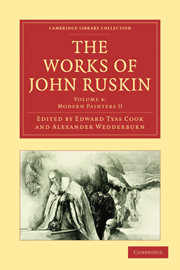Book contents
- Frontmatter
- Contents
- LIST OF ILLUSTRATIONS
- INTRODUCTION TO THIS VOLUME
- BIBLIOGRAPHICAL NOTE
- MODERN PAINTERS
- AUTHOR'S PREFACE TO THE RE-ARRANGED EDITION (1883)
- AUTHOR'S SYNOPSIS OF CONTENTS
- PART III OF IDEAS OF BEAUTY
- SECTION I OF THE THEORETIC FACULTY
- SECTION II OF THE IMAGINATIVE FACULTY
- INTRODUCTORY NOTE (1883)
- CHAPTER I OF THE THREE FORMS OF IMAGINATION
- CHAPTER II OF IMAGINATION ASSOCIATIVE
- CHAPTER III OF IMAGINATION PENETRATIVE
- CHAPTER IV OF IMAGINATION CONTEMPLATIVE
- CHAPTER V OF THE SUPERHUMAN IDEAL
- ADDENDA (1848)
- AUTHOR'S EPILOGUE TO THE RE-ARRANGED EDITION (1883)
- APPENDIX
- Plate section
CHAPTER II - OF IMAGINATION ASSOCIATIVE
Published online by Cambridge University Press: 05 September 2013
- Frontmatter
- Contents
- LIST OF ILLUSTRATIONS
- INTRODUCTION TO THIS VOLUME
- BIBLIOGRAPHICAL NOTE
- MODERN PAINTERS
- AUTHOR'S PREFACE TO THE RE-ARRANGED EDITION (1883)
- AUTHOR'S SYNOPSIS OF CONTENTS
- PART III OF IDEAS OF BEAUTY
- SECTION I OF THE THEORETIC FACULTY
- SECTION II OF THE IMAGINATIVE FACULTY
- INTRODUCTORY NOTE (1883)
- CHAPTER I OF THE THREE FORMS OF IMAGINATION
- CHAPTER II OF IMAGINATION ASSOCIATIVE
- CHAPTER III OF IMAGINATION PENETRATIVE
- CHAPTER IV OF IMAGINATION CONTEMPLATIVE
- CHAPTER V OF THE SUPERHUMAN IDEAL
- ADDENDA (1848)
- AUTHOR'S EPILOGUE TO THE RE-ARRANGED EDITION (1883)
- APPENDIX
- Plate section
Summary
Of simple Conception
In order to render our inquiry as easy as possible, we shall consider the dealing of the Associative imagination with the simplest possible matter,—that is, with conceptions of material things. First, therefore, we must define the nature of these conceptions themselves.
After beholding and examining any material object, our knowledge respecting it exists in two different forms. Some facts exist in the brain in a verbal form, as known, but not conceived; as, for instance, that it was heavy or light, that it was eight inches and a quarter long, etc., of which length we cannot have accurate conception, but only such a conception as might attach to a length of seven inches or nine; and which fact we may recollect without any conception of the object at all. Other facts respecting it exist in the brain in a visible form, not always visible, but visible at will, as its being of such a colour, or having such and such a complicated shape: as the form of a rose-bud for instance, which it would be difficult to express verbally, neither is it retained by the brain in a verbal form, but a visible one: that is, when we wish for knowledge of its form for immediate use, we summon up a vision or image of the thing; we do not remember it in words, as we remember the fact that it took so many days to blow, or that it was gathered at such and such a time.
- Type
- Chapter
- Information
- The Works of John Ruskin , pp. 229 - 248Publisher: Cambridge University PressPrint publication year: 2010First published in: 1903



